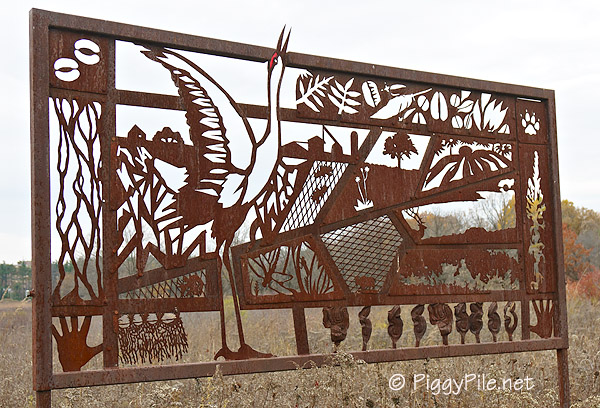Let's see what we can find out about turkeys.
First we need to get in our turkey blind so we can hide from them.
This is the most common of the five subspecies, the eastern wild turkey.
It's an adult male. You can tell because the beard, which looks like a horse tail but is actually made up of modified feathers, is long. In some populations of wild turkeys, up to 20% of the females have beards, but they're a lot shorter than the male's.
In the early 1930s, there were only about 30,000 turkeys in North
America due to hunting and the loss of habitat. They vanished from 18
of their native 39 states. State wildlife agencies and The National
Wild Turkey Federation are responsible for bringing the population up to
7 million. This was done
through a combination of trap-and-transfer and conservation efforts.
Even so, populations are starting to decline again, particularly in some of the southeastern states, by 30 - 65% in the last decade. Scientists think it's a combination of factors including an increase in predators (raccoons, coyotes, and feral hogs) and a decrease in habitat quality and quantity (primarily through unsustainable timber harvests.)
Tradition tells us that turkey was part of the first Thanksgiving feast at
Plymouth Colony, Massachusetts, in 1621. But is that true?
There's
only one surviving document, written by colony governor Edward Winslow,
that describes the feast. He said they "sent foure men on fowling,
that so we might after a special manner rejoyce together after we had
gathered the fruit of our labours." According to the culinary expert at
Plimoth Plantation, when an Englishman referred to "fowling", he
usually was talking about water fowl - geese and ducks.
Another commonly-held belief is that Benjamin Franklin proposed the wild turkey be the national bird. Not so.
People were misconstruing his comments in a letter to his daughter. He said the bald eagle was "of bad moral Character". The wild turkey, on the other hand, was "a much more respectable Bird ... though a little vain & silly, a Bird of Courage, and would not hesitate to attack a Grenadier of the British Guards who should presume to invade his Farm Yard with a red Coat on." But these were just observations to a family member, not official proposals.
Females feed the chicks for only a few days after they hatch. Males
don't feed them at all. It could be worse. At least they let them hang
around so they can all forage together. Some wild animals, like
lions, sometimes kill cubs that they haven't sired.
Most of the turkey's diet is vegetarian, aside from the occasional insect, amphibian, and reptile. And most of their foraging is done on the ground, although they sometimes climb shrubs and trees to get their food.
Domestic turkeys have white-tipped tail feathers, not brown ones like this.
This is an adult, because all the tail feathers are the same length; jakes (immature males) have longer feathers in the middle.
The turkeys we saw this day got to stroll past these tamarack trees. Tamarack is an Algonquian word that means "wood used for snowshoes".
Take a look at the huge feet on the turkey in the previous photograph. They're almost built-in snowshoes. Big feet are good at scruffing up the ground while looking for
food. Plus, you need big feet to support that big body. Males
generally weigh between 11 and 24 pounds; females between 5 and 12
pounds. The largest male weighed by The National Wild Turkey Federation
was 37 pounds.
Gratuitous, pretty, shot of a shrub that was in the foraging area of the turkeys.
So what have we learned from our turkey research?
We learned this is NOT a turkey.
And we learned they can't read.













No comments:
Post a Comment
Your comment won't display immediately.